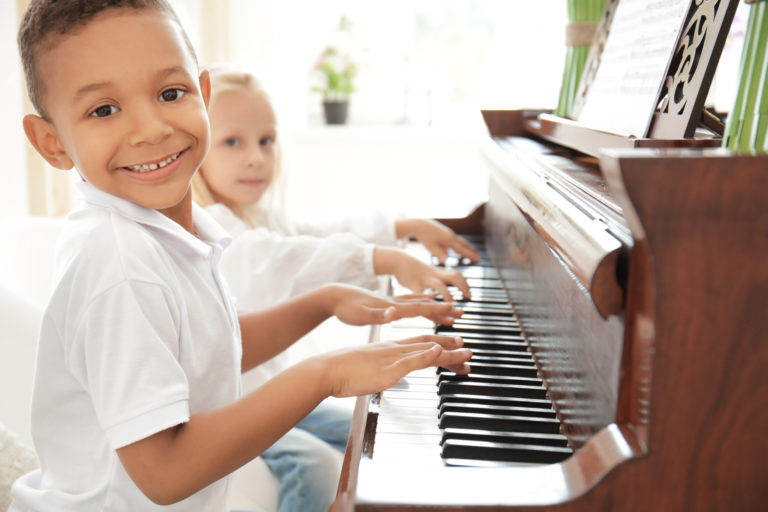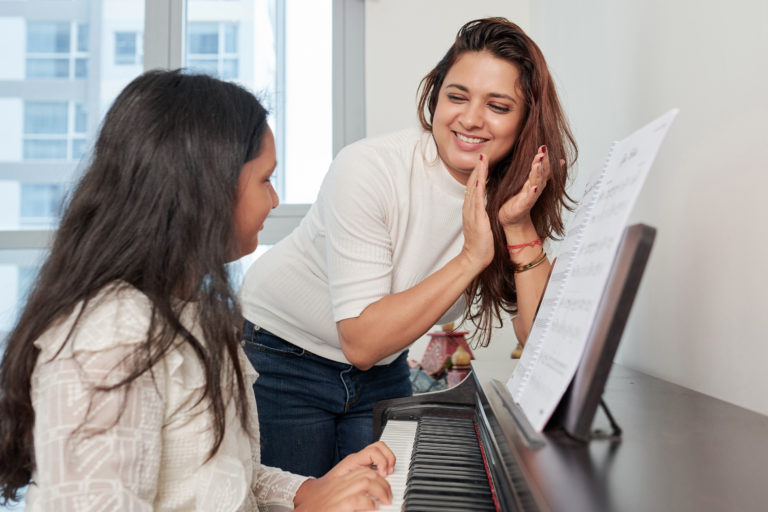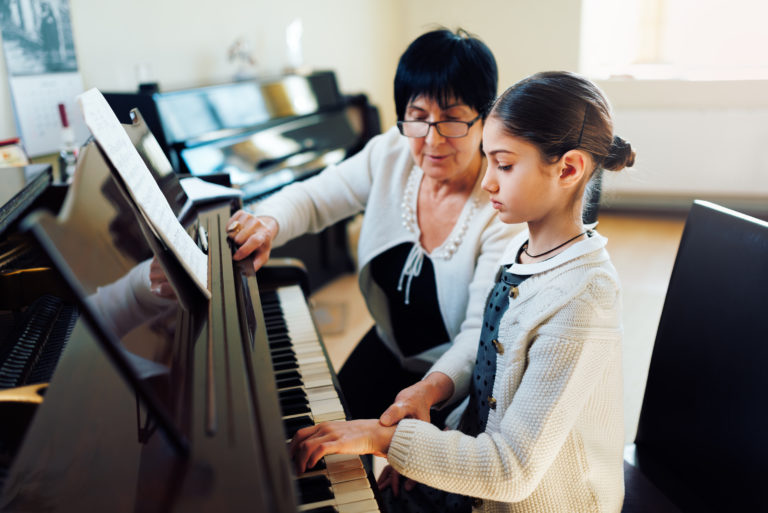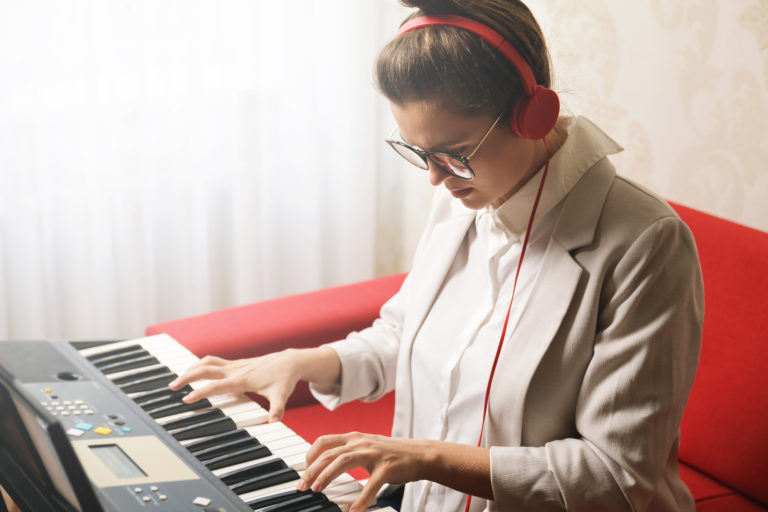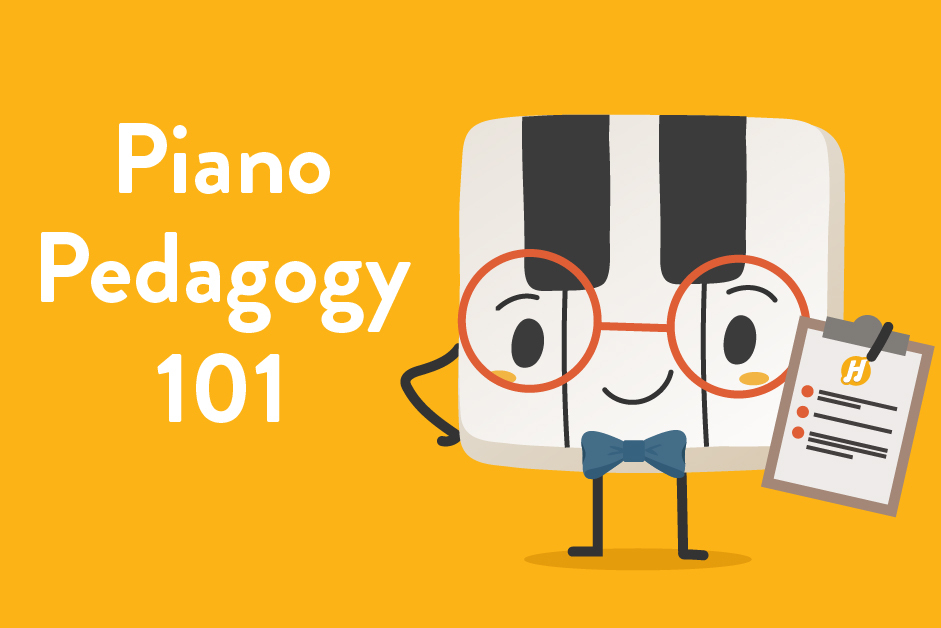Some of the links in this article are affiliate links, which allow us to earn a commission when you use them to make a purchase. This helps us continue to create fun music learning experiences for everyone to enjoy.
What is piano pedagogy? Learn all about it below, including some useful resources
The study of teaching piano is called piano pedagogy. Are you a parent wanting to support your child in piano lessons or a person interested in becoming a piano teacher and want to see what it takes? In this article, we will give a brief introduction to piano pedagogy, discuss the basics, and provide recommendations for resources that can be used to teach piano lessons.
If you are a piano teacher interested in using the Hoffman method in your own teaching check out our Teacher Training Series. This training series allows you to learn the teaching principles and techniques that make the Hoffman Method unique and effective and integrate them into your own teaching.
What are the basics of piano pedagogy?
The basics of piano pedagogy include:
- Creating a safe and positive learning environment
- Training proper posture and technique
- Building music literacy and an understanding of music theory
- Assigning goals and rewards that motivate your students
- Choosing repertoire that is appropriate for the student’s age and level
- Sequencing learning activities to maximize retention and understanding
- Frequent review and reinforcement of what the student has already learned
As a piano teacher there are so many things to consider when teaching a student, but using the appropriate method and individualizing your approach to each student can be the key to success. Additional things to consider while teaching include the student’s age, their musical background, their general and musical likes and dislikes, their mobility, and any other personal hurdles that they may encounter.
There are many different piano teaching methods available today. Below is a list of several popular and distinct methods.
What are the different piano teaching methods?
Traditional Sight Reading Methods
Traditional sight reading methods are popular methods that are inexpensive and easy to find online or at your local music bookstore. These include the Faber Piano Adventures series, Alfred’s Basic Piano Library series, the James Bastien series, and the John Thompson’s Modern Course for the Piano series. These methods emphasize reading music notation as the primary way to learn music, but they don’t stress the importance of other musical skills such as transposition, improvisation, aural skills, and composition.
Suzuki Method
Shinichi Suzuki was a violin pedagogue who developed a method that focuses on learning music through listening and repetition. This method was originally developed for violin students, but has also become very popular for teaching other instruments such as piano. Encouraging a student to learn through listening and repetition means that a student learns to acquire and understand music in a similar fashion as one learns to speak, but the student is not encouraged to learn to read music until much later in their learning journey. For this method to be successful, a certified Suzuki method teacher is necessary. One important note on this method is that it requires a high level of dedication on the part of both student and parent. Parents need to be involved in helping their children while at home.
Hoffman Method
The Hoffman Method, developed by Joseph Hoffman, combines the best of a traditional sight-reading method and the intuitive musicality of the Suzuki method with an emphasis on creativity, musical expression, and fun. By recognizing the individual aspects of musicianship as skills that can be developed through exploration and practice, the Hoffman Method nurtures students to become well-rounded musicians who can sight read, play by ear, compose, improvise, dictate, transpose, and more, even early on in their training. More than just a piano method, the Hoffman Method builds a strong foundation that creates confident musicians for life.
An important advantage of the Hoffman Method is that it makes full use of modern technology. With video lessons, online music learning games, audio tracks for both listening and playing along, interactive practice instructions, a vast library of downloadable sheet music and other learning resources, the Hoffman Academy website has everything you need to support piano teaching and learning.
Taubman Method
The Taubman Method was developed by Dorothy Taubman and emphasizes a natural, healthy, and efficient approach to playing the piano. This method is popular with students who need to overcome technical challenges or past injuries and includes rotational movements and techniques for coordination, hand positioning, and tension release.
Other Music Teaching Philosophies
While not as formalized as music teaching methods, which include a set curriculum, here are some popular approaches to music education that provide guiding principles to music teachers.
Kodály
Kodály is an approach to learning music that was developed by Hungarian composer and educator Zoltán Kodály, which focuses on teaching musical concepts through learning solfege and the singing of folk songs. This method emphasizes ear training, musical literacy, and audiation skills and is accessible for students of any age. The Kodály philosophy of music teaching aims to develop strong musical foundations by beginning with simple songs and building towards more challenging musical concepts.
Orff
Developed by German composer Carl Orff (famous for his Carmina Burana), this style of music teaching focuses on group learning through singing, movement, chanting, and the playing of instruments. This teaching philosophy deals less specifically with the piano and uses pitched percussion instruments to introduce and practice musical concepts. Orff instruments include xylophones, glockenspiels, and metallophones to explore musical concepts with a hands-on approach. Orff uses elemental forms of music such as simple melodies and rhythmic patterns to develop creativity, a strong sense of rhythm and pitch, and improvisational skills in students of all ages.
How should piano lessons be structured?
Advantages of the Hoffman Method
Nowadays, so many piano learning methods are geared towards reading music, but lack other important musical training. There are stories of classical musicians such as J.S. Bach who could sit down and improvise a completely original fugue from scratch. Fugues are known for their complexity with multiple individual voices being played against each other. Today this seems to have become a lost art. In its place, many jazz musicians are known for their abilities to improvise, but improvisation seems to have been lost from standard classical training – at least at the beginner and intermediate level.
One common misconception about piano teaching is that students should only focus on being able to sight read and play the notes on their sheet music. At Hoffman Academy, we believe in providing students with a whole-music approach that gets students to not only sight read and play repertoire and scales, but also play from lead sheets, piano chord charts, and freely and confidently improvise and compose. We want our students to own their musical creativity and expression. This is why Joseph Hoffman created our method by combining the best parts of the Kodály method, Suzuki method, and traditional sight-reading methods.
Becoming a piano teacher
Are you a pianist who is interested in becoming a piano teacher? Maybe there’s a lack of piano teachers in your area and you know piano and want to start teaching. To get started, first choose a method that you feel aligns with your own teaching philosophy and goals. There are many methods that you can choose from, so talk with experienced teachers to find one that works for you. Once you choose a method, buy a copy and review it.
You’ll also want to be sure to find materials, games, resources, and other teaching aids with which you can fill your teaching studio. For ideas and suggestions, check out our article What Every Piano Teacher Needs in Their Studio. Then you’re ready to advertise your business! Having a website can be a helpful way to find new piano students. Don’t forget that you can network by joining your local professional music teachers’ association, like your state chapter of MTNA.
You can learn more about teaching with the Hoffman Method here.
Piano pedagogy resources and books
You can find all sorts of piano teaching resources with which to fill your studio by browsing our store’s resource page on our website. You will find fun musical games, finger puppets, heartbeat mats, flashcards, finger power guides and aids, blank staff paper for composing, packets, and guides. Many of these resources are free, and others can be purchased with a small fee.
Also, check out this list of our favorite piano pedagogy books that can help you become the best teacher that you can be! All of these books come highly recommended from Joseph Hoffman and other Hoffman Academy teachers.
Nurtured by Love – Shinichi Suzuki
How to Teach Piano Successfully – James Bastien
Professional Piano Teaching – Jeanine M. Jacobson
Intelligent Music Teaching – Robert Duke
The Perfect Wrong Note – William Westney
Piano Playing with Piano Questions Answered – Josef Hoffmann (Yes, there is another piano pedagogue who shares our Joseph Hoffman’s name! Notice the different spelling.)
A book that is used by a lot of piano teachers is W. Timothy Gallwey’s The Inner Game of Tennis. As you may notice from the title, it is not a book on teaching piano, but the concepts that it discusses make it a very popular book for people training to do a task. For example, Al Gore has used this book to train his campaign staff and famous violinist Itzhak Perlman is known to recommend it to his students. The “inner game” discussed in the book is the game within a performer’s mind, which includes hurdles such as self-doubt, nervousness and anxiety, and trouble concentrating.
As you can see, there is a lot that goes into teaching piano, whether that be learning to read music, the art of actually playing the instrument through specific healthy movements, improvising, or learning to play music by ear. Piano pedagogy is a very important study that allows pianists to approach the instrument in a confident and healthy manner.
